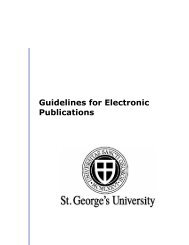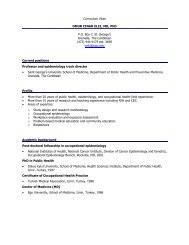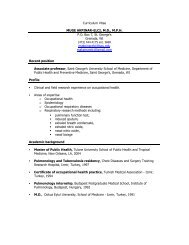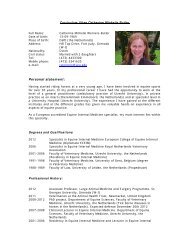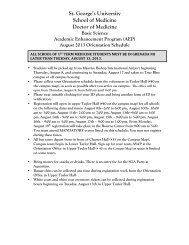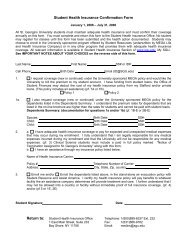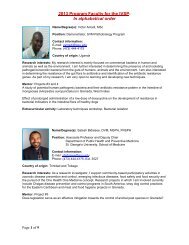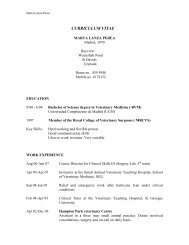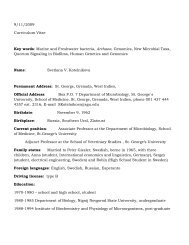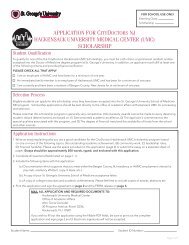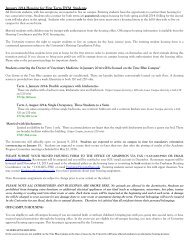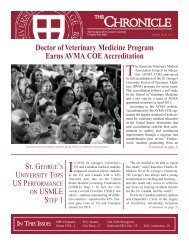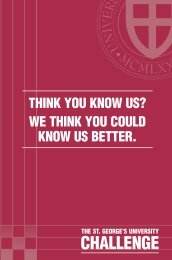SCHOOL OF 2012-2013 - St. George's University
SCHOOL OF 2012-2013 - St. George's University
SCHOOL OF 2012-2013 - St. George's University
You also want an ePaper? Increase the reach of your titles
YUMPU automatically turns print PDFs into web optimized ePapers that Google loves.
School of Medicine<br />
Finances<br />
to pay a 1.051% origination fee on Unsubsidized loans and a<br />
4.204% origination fee on Direct PLUS loans. This fee will be<br />
subtracted from the amount borrowed, and will be reflected<br />
in the disbursements issued to the student’s account.<br />
Loans are typically processed for an academic year and<br />
are disbursed in two installments. Disbursements typically<br />
occur 10 days before the start of an academic term.<br />
For example, if a student requests an $20,500 Federal<br />
Direct Unsubsidized <strong>St</strong>afford Loan, the Department of<br />
Education will release half the requested amount, minus<br />
any applicable fees for the first term of the academic year<br />
and release the second half of the approved amount (minus<br />
fees) 10 days before the start of the second term.<br />
Under the Direct Unsubsidized and Graduate PLUS loan<br />
programs, the student is responsible for all accruing<br />
interest and may choose to repay the interest while in<br />
school or defer it until repayment begins. Upon graduation,<br />
a grace period is applied automatically to your Federal<br />
Direct <strong>St</strong>afford loans. The grace period is a six-month<br />
period of time during which no payments are required,<br />
although interest will continue to accrue on these loans. If a<br />
student ceases to be enrolled at least half time (withdraws<br />
or takes a leave of absence), the six-month grace period<br />
would apply in most circumstances. There is no grace<br />
period for Direct Graduate PLUS loans.<br />
<strong>St</strong>udents can apply for US federal loans by completing the<br />
Free Application for Federal <strong>St</strong>udent Assistance (FAFSA)<br />
at www.fafsa.ed.gov. When completing the FAFSA, be<br />
sure to the appropriate school code. The SGU School of<br />
Medicine federal school code is G22333. <strong>St</strong>udents will also<br />
need to complete an online Entrance Counselling session<br />
and Master Promissory Notes in order to complete the<br />
application process.<br />
To receive Direct Loans, recipients must be either permanent<br />
residents or citizens of the United <strong>St</strong>ates, be enrolled in the<br />
School of Medicine at least half time, maintain satisfactory<br />
academic progress, and not be in default on any prior U.S.<br />
government guaranteed loan. These guidelines are subject<br />
to statutory and/or regulatory changes in the U.S. Higher<br />
Education Act and the Title IV Program Regulations.<br />
For details on how to apply, visit sgu.edu/somloans.<br />
Private Educational Loans<br />
Private educational lenders in the United <strong>St</strong>ates offer <strong>St</strong>.<br />
George’s US students alternate loans. <strong>St</strong>udents can obtain<br />
these loans to meet all or part of their cost of attendance.<br />
These private loan programs are all credit based and are<br />
offered only to students who have a satisfactory credit<br />
history as determined by the lender. The loans typically<br />
have a variable interest rate, with the interest rate tied<br />
to an index, such as LIBOR or PRIME, plus a margin. The<br />
interest rates and fees you pay on a private student loan<br />
are based on your credit score and the credit score of your<br />
cosigner, These loans have repayment terms that begin<br />
following graduation or withdrawal from school and may be<br />
extended up to 20 years.<br />
The Financial Aid Office at SGU provides extensive financial<br />
aid counseling services to students in order to help them<br />
understand the eligibility requirements, terms and conditions.<br />
Canadian Citizens<br />
<strong>St</strong>. George’s <strong>University</strong> is approved by the Canadian<br />
Ministry of Education, entitling most students to the<br />
ability to receive Canadian federal loans, provincial loans<br />
and federal grants. The Canada <strong>St</strong>udent Loans Program<br />
(CSLP) offers financial assistance to full-time and parttime<br />
students pursuing post-secondary education in the<br />
form of loans, grants and repayment assistance. The CSLP<br />
delivers student financial assistance in partnership with<br />
most provinces and territories. Quebec and the Northwest<br />
Territories operate their own programs.<br />
These loans are interest-subsidized by the Canadian<br />
government while the student is enrolled in school<br />
and maintaining satisfactory academic progress as<br />
determined by the individual province. Below you will find a<br />
comprehensive list of available funding by province.<br />
To supplement the financing of their education, students<br />
usually apply for a professional line of credit available<br />
through the banks in Canada. Credit lines are normally<br />
approved for up to $200,000 however the bank will require<br />
a co-signer.<br />
<strong>St</strong>. George’s <strong>University</strong> is committed to ensuring that<br />
students are aware of all their financial aid options and we<br />
have designated a counselor to work directly with you to<br />
address your questions and needs.<br />
118 | <strong>St</strong>. George’s <strong>University</strong>



